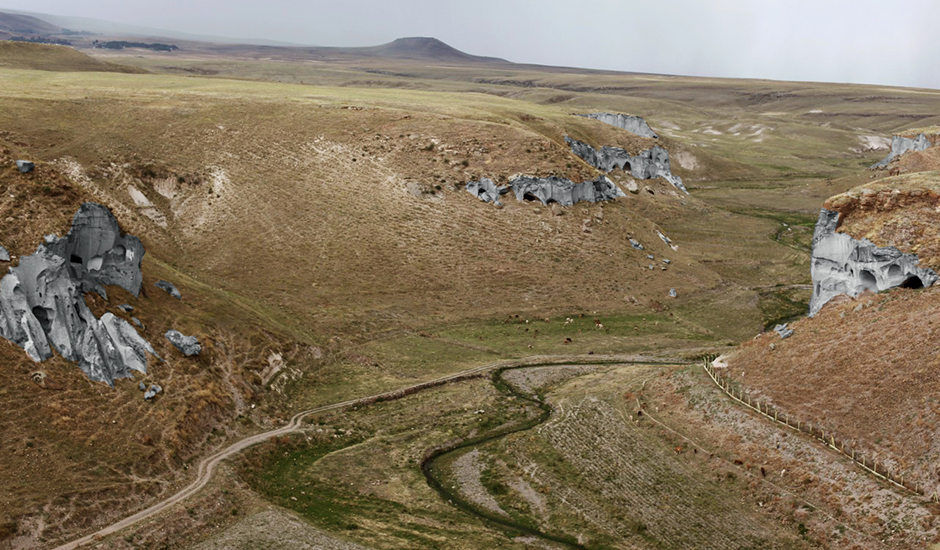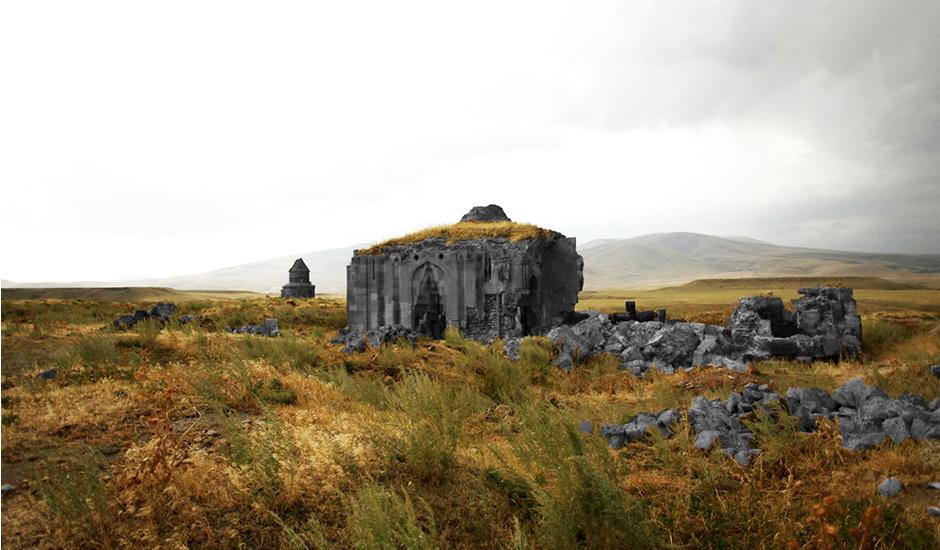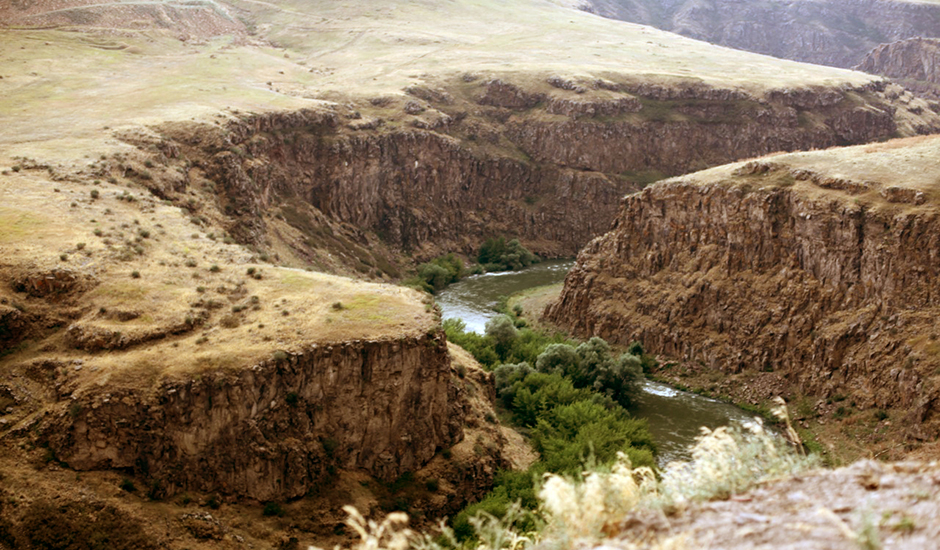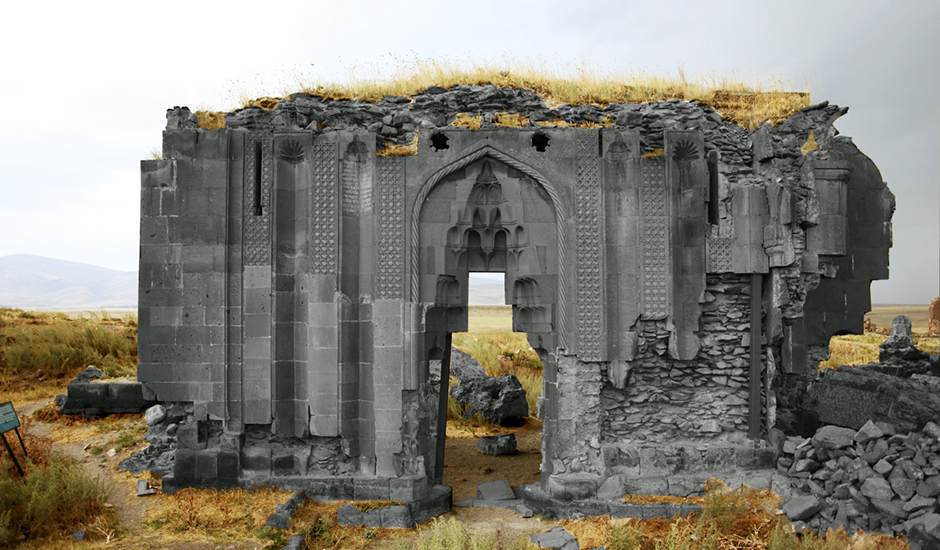Text commissioned by Arteeast, Silence issue edited by Hakan Topal
www.arteeast.org/2012/02/15/silence-of-the-land/
So, the stone falls on the city, the earth quakes and thus shakes our walls and our constructed certainties; nature bursts in on the citizen, who believes only in the assurances provided by human labor and by the political order or police. [1]
SHEEP
A friend [2] of mine once shared a story about his father who was serving as a military veterinarian at a border city in Eastern Anatolia in the 1960s. The story involves Republic of Turkey, the USSR, the border between them, military officers and protocols, shepherds, sheep, and grass. The story goes that the sheep, naturally unaware and uninterested in the concept of national territory and borders, would often cross to the Soviet side for taller and un-grazed, therefore tastier, grass. While for the sheep this practice would mean grazing for sustenance, for the nation states it would constitute an illegal border crossing. As a result, the retrieval of the sheep would set off a series of diplomatic and military procedures and protocols to be observed by the officers. Once the diplomatic rituals were completed, the shepherds would be allowed to cross the border and recover their animals.
In this story, two overlapping spaces exist. First, there is the space of the sheep, a continuous and fluid geography, where boundaries—in the absence of man-made ones—are only defined by topographical impediments such as a gorge or a cliff. As long as grass grows, the land of the sheep keeps expanding, there are no borders. Sheep inhabit a “natural” space [3].
Second is the space of the state which involves rules and protocols, visible and invisible borderlines which ultimately characterize a territorial and aerial sovereign space. In other words, this space of the nation state consists of virtual lines superimposed on the surface of the earth to delineate territories which are to be protected. In this process of delineation, nature is transformed into possession.
This is perhaps why I was so intrigued when I encountered an article in a Turkish newspaper that involved, once again, sheep, borders and architectural ruins. It was an article which was rightly drawing attention to the negligence of the archeological site of the city of Ani in Kars, Turkey. The article was titled:
“They are letting animals graze in the ruins of Ani…” [4]
[“Ani harabelerinde hayvan otlatiliyor.”]
The article concurs that the sheep have no place in Ani; their existence is the ultimate ruin of the ruins. While Ani is similarly a border town, this time the sheep are not illegally border crossing but instead ‘violating’ a different delineated territory: an archeological ruin site. The news article sets the sheep in opposition to the ruins, and with the same token, natural space in opposition to man-made space, that of architecture and cultural heritage.
The grim conditions of the buildings in which they are left to disintegrate are clearly visible. Ani stands as a ghost town with half remaining buildings and no inhabitants with the exception of occasional tourists and grazing animals. While the neglect and the reasons for the negligence are of utmost importance to address, the investigation of the inherent assumptions in pitting the sheep as the antithesis of the ruins may offer a clue in understanding such sites and our preconceptions.
(De)FORMATIONS
The city of Ani is a fascinating site, situated at the border with Armenia, northeast of Turkey. It became the capital of the Armenian Bagratid dynasty, when their king Ashot III transferred his capital from Kars to Ani. Since it was located at the cross-roads of the Silk Road, the new capital prospered. The city had many beautifully designed and built churches and monasteries. For that reason it was called the “city of a thousand and one churches.”
Since its inception, Ani has seen many brutal invasions and destructions by various armies as well as repetitive seismic tremors in the years 1064, 1263, 1319 and 1988. There is an account that the earthquake of 1064, which demolished the city’s fortification walls, opened the gates for the Seljuk invasion.
With the disintegration of the Silk Road as well as a series of destructive earthquakes and raids, Ani was ultimately abandoned by the 19th century. After a period of Russian rule between 1878 and 1918, it was included within the boundaries of Turkey after the collapse of the Ottoman Empire. [5]
In Ani, the collapsed buildings are spread over the landscape stone by stone and the half standing buildings are taken over by the landscape. The buildings have been ‘re-stored’ back to earth they were quarried from as grass grows on top of the existing and once-existed buildings and roads. The ruins exist as artifacts that are suspended between architecture and nature, and between presence and absence. It is in this in-between state that architecture and nature coalesce, and the complex constellation of forces that are at play in bringing about a physical space are revealed.
Places with intense and sedimented history are made of intricately interwoven formations and deformations. Ani is conceived of the Akhurian/Arpacay river, its topography, the rock formation it is located on, its climate, as well as the earthquakes, the floods, and the draughts. Simultaneously it is formed by its architecture, its situation, its population as well as the wars, atrocities, invasions, demolitions, and political and economic ruptures that have weathered it into its current state. If we accept that a place is the growth of a perpetually converging processes of all these constituents—natural and man-made formations and deformations alike, why should the ruins be protected from sheep which belong to that land no less than the built work? The assumed hierarchy between cultural heritage and nature (earth) is artificially induced similar to the juxtaposition of the national borders over grazing grounds. The word culture in its earliest known use around 1450 included working the nature in its definition [6] and as late as the end of the 18th century the word culture took on the meaning that is most commonly used today no longer including nature in its definition:
“intellectual and artistic conditions of a society or the (perceived) state of development of those conditions, also the ideas, customs, etc. of a society or group (1796, after German Kultur)” [7]
The content of culture shifts from an agricultural activity to the collective production of a society around the same time the word nationalism is used at the end of 18th century and the concept is believed to be born. The transformation of the meaning of the word is critical as it reveals a shift in the way in which we comprehend the idea of landscape and architecture today. Before this shift, the act of the sheep walking towards taller grass fell within the realm of culture in its earlier definition along with working the soil and building shelter. After the shift, nature’s role is marginalized in the production of physical space and culture.
It is challenging to deal with such symbolically charged and politically contested site. Ani, founded as an Armenian city in the 10th century today is within the borders of Republic of Turkey just a river away and visible from today’s Armenia. The borders between these countries are currently closed and political ties strained. The only thing that has not changed in the span of 11 centuries is a surface that holds all together and onto which all eventually falls, the earth. Earth that has been silenced over time in the definition of what we perceive as culture today can be a negotiating ground in understanding and re-interpreting Ani. Once we can look at it without the nationalist blueprints and maps that imprint ownership everywhere we can finally claim the sole landlord as “the earth that shall be left to no one.” [8] The sheep can graze and we may start searching for an alternative definition for ‘restoration.’
Notes:
[1] Michel Serres, Natural Contract, 1995
[2] Thanks to Ersan Ocak for sharing this gem of a story with me.
[3] It is the space within which the sheep exists that is ‘natural’, not necessarily the sheep per se. Sheep are domesticated animals, hence they are to a certain degree man-made.
[4] From the news article: “Ani Harabeleri’nde Hayvan Otlatılıyor”, 27 June 2008, Haberler.com http://www.haberler.com/ani-harabeleri-nde-hayvan-otlatiliyor-haberi/
[5] A good account and bibliography regarding Ani can be found at: http://www.virtualani.org/history/
[6] Culture: the action or practice of cultivating the soil; tillage; = CULTIVATION, Oxford English Dictionary
[7] ibid
[8] From Yunus Emre, an Anatolian poet and mystic.
Photographs by Hakan Topal, edited by Aslihan Demirtas




